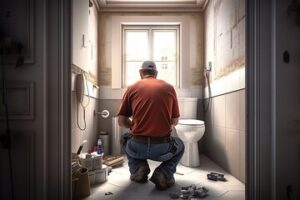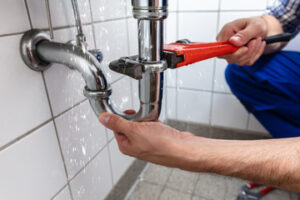Clogged drains are not only a nuisance, but they can cause damage to your pipes and cause costly wastewater backup. Ask On Point Plumbing & Heating what causes blocked drains and what you can do about them.
The most common reasons for clogged drains are hair in bathtubs and showers, food waste in sinks, “flushable” wipes, paper towels, toilet tampons, and mineral buildup from hard water that prevents drain lines from flowing properly.

FOGs, or fats, oils, and grease, are the main culprits of clogged drains. These villains can cause serious sewer blockages if they are improperly disposed of. Grease is a thick substance that can clog pipes if improperly washed away. When you pour cooking grease down the drain, it may liquefy and flow through the pipes. However, once it cools, it can solidify on the walls of the pipes. This can result in a large and hard-to-remove clog.
Many people will try to dissolve the clump of grease by pouring hot water down the drain. This may sometimes work, but there are more permanent solutions. It is also not safe for the pipes. Pouring boiling water down the drain can push the grease farther into the pipe, resulting in even bigger problems.
The best way to deal with grease clogs is to use commercial products specifically designed for this purpose. These products can be found at most hardware and grocery stores. You can also find these products online. There are also several home remedies that you can use to help with the problem. These include using Vinegar and baking soda.
Pouring a small amount of baking soda and Vinegar down the drain can produce a fizzing reaction that breaks up and liquefies grease. Baking soda is an excellent abrasive that can help break down clogs and remove them from the pipes.
Another great way to remove grease is using a caustic cleaner containing sodium hydroxide (NaOH). This can be purchased at most hardware and grocery stores. There are better solutions for small clogs, but they can be used on larger ones.
Another common cause of clogged sinks is using soaps that contain animal or vegetable fats. It is recommended to switch to soaps that are fat-free. There are several different types of fat-free soaps available. Call a professional plumber for assistance if you are dealing with a severe grease clog.
Many people must refrain from throwing food scraps and leftovers into their kitchen drains, which can contribute to clogged pipes. Grease, oils, and fats are liquid when poured down the drain, but they solidify as they cool, resulting in greasy clogs that can be difficult to remove without professional help. Fibrous foods like eggshells, coffee grounds, and onion skins can also clog your pipes because they don’t dissolve easily in water.
Flour is another common household food item that can cause a drain clog. When mixed with water, flour forms a glue-like substance that can clog your pipes. To avoid this, brush your remaining flour into the trash rather than rinsing it down the drain.
Similarly, pasta and rice can clog your pipes because they absorb water, causing them to swell up and block the pipe. These foods can also contribute to clogs in your garbage disposal unit, so throwing small amounts into the drain is best.
One of the most overlooked causes of clogged drains is hair, which can quickly build up and become a major problem. Both human and pet hair can accumulate in your pipes and lead to a clogged drain, especially when it mixes with grease and soap residue.
In addition to hair, other food waste can also clog your drains. Coffee grounds and eggshells are non-biodegradable and can clog your pipes if disposed of improperly. It’s important to regularly clean your drains with homemade solutions or commercial products to prevent these substances from building up and clogging your drains.
In addition to preventing drain clogs, regular cleaning can help maintain the efficiency and longevity of your plumbing system. Pouring baking soda and Vinegar down your drains can create a chemical reaction that will dissolve most clogs, while running hot water afterward can help move the clog away from your pipes. However, if you are experiencing a serious clog, contacting a plumber for professional assistance is best. They can inspect your pipes and recommend the right solution for your home.
Hair is a leading cause of clogged drains, especially in bathrooms and bathtubs. We lose anywhere from 50 to 100 hairs a day, and those little strands end up in the drains, where they can mix with other debris to create a solid clog. If a hair clog isn’t addressed quickly, it can lead to a slow-draining shower or sink or a complete blockage.
Fortunately, it’s easy to clear hair clogs with the right technique. One option is to use a hook to fish the clump of hair out of the drain. This can be as simple as fashioning a hook out of a wire or a coat hanger, but you can also find special tools designed specifically for this purpose. Another option is using a chemical drain cleaner labeled safe for hair clogs. Follow the instructions on the bottle to apply the chemical safely and effectively.
Another effective way to remove hair from the drain is to brush it before stepping into the shower or tub. This can help prevent many tangled masses of hair from easily getting into your drains. You can also install a shower drain cover, which is relatively inexpensive and sits on top of your drain to catch hair before it goes down. These are available at most home improvement stores.
Plumbing pipes are a challenging system to keep in working order. Much of the sewer and house drains are underground or hidden from view, making it easier to spot problems once they’re well established. Keeping an eye out for warning signs of drain issues may help you nip problems in the bud before they become serious and costly.
Paper products are one of the biggest contributors to clogged toilets. While the only thing that should ever go down a toilet is toilet paper, many household and business items can end up in drains if you must be careful. Items like facial tissues, sales receipts, q-tips, and wipes (even those that claim to be flushable) can all cause bathroom blockages. They’re also not good for the environment or your pipes.
If you use these products regularly, consider investing in a disposal unit. They’ll save you time and money in the long run.
Other common causes of clogged drains include improper disposal of food particles, soap scum, foreign objects, and mineral buildup in areas with hard water.
Many of these problems can be resolved with a simple plunger or a snake, but in some cases, it’s necessary to call a plumber to remove a blocked pipe or replace a broken pipe. It’s also wise to avoid do-it-yourself drain cleaners, like vinegar and baking soda, as they can sometimes worsen a blockage.


